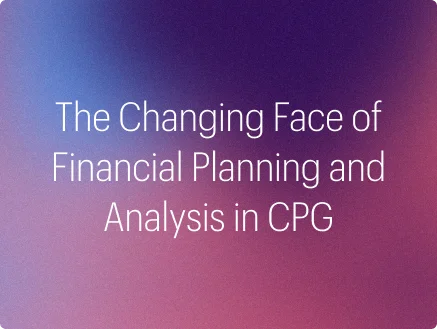As Consumer Packaged Goods (CPG) companies adjust to the aftermath of the pandemic, they are facing unprecedented challenges. Many of these organizations are just now beginning to feel the full effects of unfavorable economic factors and need to make changes to their businesses in order to keep up. For some, it is not enough to make minor adjustments and wait this period out, as a multitude of issues across departments have been exposed that these companies need to address if they wish to prioritize long-term growth. Additionally, some factors, such as consumer shopping tendencies and market behavior, seem to have changed for the foreseeable future. Thus, it is important for CPG companies to evaluate their own practices in an effort to respond to the evolving market and to address long-term concerns and inefficiencies.
One such business function that CPG companies should consider making changes to is sales, both by narrowing the responsibilities of the sales function and by effectively utilizing digital tools to enhance performance. In this article, we examine the landscape of sales operations—past and present—and the importance of both implementing and driving the adoption of changes to the sales function within CPG companies.
The current state of the sales function in CPG
Traditionally, one of the primary functions of sales operations was to create a sales forecast, which involves determining how many units of a product can be sold within a given period and for what price. This informs the entire organization’s budget and affects all other functions within a company. They are also responsible for communicating the value of a product to the consumer and convincing them that it is worth purchasing, acting as a touchpoint between a company and its target market. Thus, the sales team plays a critical role in ensuring that the consumers’ needs and wants are satisfied by the products the organization is developing and that the price they are offering the product for is one the customer is willing to pay.
In recent years, the responsibilities of the sales function have grown, with companies expanding the necessary qualifications and customers having higher expectations from sales team personnel. This has often over-exerted the sales team and diverted attention away from business drivers and towards time-consuming administrative tasks. Many organizations have invested in some form of automation or digital tool that can streamline a variety of tasks and improve the capabilities of sales operations. However, these tools are often underutilized for a variety of reasons, including results that are difficult to interpret or do not directly address the needs of the sales team. It is clear that CPG companies need to implement changes to address the added responsibilities and expectations of sales, but many are not going about it in the right way.
Business value-additions of revamping the sales operation
#1. Increased focus on the customer:
Despite the importance of the sales function, in recent years, many organizations have continually under-invested in them. This has shifted the focus of the sales team away from prioritizing the needs of the customer and more towards administrative and transactional responsibilities. These tasks, while essential, are not drivers of growth and performance, so it is important that CPG companies enable their sales teams to focus on the customer and determine the optimal combinations of products and prices that most appeal to buyers.
Leading CPG companies are shifting the priority of the sales team back to the customer in a multitude of ways. Some are automating these administrative and transactional tasks, speeding up the sales process, and ultimately resulting in a better customer experience. Others are creating an additional position called ‘sales enablement’ or ‘sales effectiveness’ [1]. Their responsibility is to design programs and implement workflow improvements that increase the effectiveness of the sales function with the customer and reduce the amount of time sales team members spend on non-value-added work. Finally, some companies are developing tools and capabilities with advanced analytics that allow the sales team to optimize prices, promotions, product offerings, etc., in accordance with the wants and needs of the customer.
One CPG organization in the US sought to better understand customer values to help its sales team. The company wanted to have access to product listings, its prices for products under specific brands and categories, along with data from multiple competitor websites. The organization reached out to MathCo for help using this information to gain an advantage through competitive pricing and enhancing the product catalog by keeping track of inventory, with the goal of better aligning promotions and inventory with consumer interest. We extracted the required data points from the list of target websites at the beginning of each day, which were then used as input to enhance the existing price elasticity model on a weekly cadence. Analyzing pricing trends for seasonal products helped us identify optimal time windows for running promotions, and we performed ad hoc analysis to identify product shortages and enhance inventory management.
#2. Managing greater expectations and responsibilities:
More so than ever, the sales function is facing enormous pressure and responsibilities, both from the companies that employ them and the consumer. As the sales team has become increasingly essential to the success of the company, the roles and responsibilities associated with the team have grown to the extent that it is difficult for any one person to deliver exceptional work in all the areas that are typically expected of them from the company. Additionally, the rise in online shopping has resulted in the consumer having higher expectations for the technical expertise of the sales team and wanting a variety of purchase options and self-service capabilities for the research of a product. In fact, a 2018 survey conducted by Statista found that 88% of adult consumers, both in the US and worldwide, expect businesses to have an online self-service portal [2].
In response to the expanding responsibilities of the typical sales team member, successful CPG companies are doing more to ensure that their top sales managers are also coaches with the skills to cultivate the growth of their employees. A study by sales expert Neil Rackham indicated that up to 87% of knowledge acquired in training is lost without any further coaching or reinforcement [3]. Examples of these improvements include weekly one-on-one coaching between the manager and each team member, training opportunities tailored to each employee’s specific weaknesses and needs, and using analytics to monitor time used for development, all of which are drivers of higher sales. Additionally, companies are relying on vendors or third-party solutions to offset some of the responsibilities of the sales team, leveraging the strengths of another resource and narrowing the scope of the sales team’s responsibilities, allowing them to better utilize their strengths.
A leading apparel company with customers across the globe began work with MathCo to alleviate some of the responsibilities of the sales team. They wanted to identify a scientific way to measure the success or failure of promotions and optimize the mix to increase effectiveness. To calculate the critical factors for the effectiveness of a promotion, we interpreted and bucketed attributes of historical promotions and devised multiple KPIs, allowing us to generate insight across multiple levels. This resulted in an 11% additional lift in promotion effectiveness, an 18% decrease in promotion costs by decommissioning failed experiments, and a USD 300M overall estimated annual impact for the company.
#3. Driving the adoption of digital tools:
As the market evolves, many strategies that sales teams traditionally employed to cultivate growth are seeing diminishing returns. It has become increasingly difficult to accurately forecast, which has forced these teams to adopt new strategies and rely more on analytics and digitization. However, this process is slow-moving. In the last several years, academic researchers have worked to compile the results of 11 independent studies and found that the failure rate of digital transformation across all disciplines was 87.5% [4]. Whether it is due to poor user interface or difficult-to-interpret results, adoption of digital tools has been low among sales teams at a time when these digital capabilities are increasingly necessary.
As consumers start prioritizing online shopping, successful CPG companies are embracing digital platforms, both internally and externally. They are selling more through digital channels and are pushing for a seamless online shopping experience for the consumer that is close to an in-person store visit. Internally, these companies are focusing not just on the usage of digital tools to enhance the capabilities of their sales team but also on the adoption of these tools. They emphasize the importance of tools that specifically address pain points of the sales function and are interactive and easy to use or interpret for any member of the sales team, regardless of technical background.
One example of increased digitization comes from the world’s largest multinational non-alcoholic beverage corporation. The company operates in over 200 counties but realized that individual MMx models with localized optimization were not effective. So, they reached out to MathCo to design a system dynamics-based solution which captures complex dynamics between brands, channels, markets, and competitors. We created an interactive, intuitive dashboard that allows teams to vary levers to determine the overall impact for themselves and account for inputs that are not possible during traditional modeling. The system was designed to scale across markets and brands. Spend optimization at a central level led to savings for the company of around USD 45MM across the top 10 markets.
Summary
The CPG industry will feel the effects of an increasingly volatile market and shifting consumer preferences for the foreseeable future, so these organizations must respond and alter their practices accordingly. One business function with a clear opportunity for improvement is sales. The expectations and responsibilities of the sales team have grown significantly in recent years, and it is essential that businesses find ways to offload some of this work. The sales function acts as the touchpoint between the business and the customer, so the majority of their responsibilities should reflect that. One way to empower the sales team is by using digital tools, which companies should build specifically with the sales team in mind to improve both adoption and usability, enabling sales to focus their time on work that more directly drives value.
Bibliography
1. “What Is Sales Enablement? The CSO’s Ultimate Guide.” Gartner. Accessed July 1, 2023. https://www.gartner.com/en/articles/the-who-what-how-and-why-of-sales-enablement.
2. “Customers: Opinion on Self-Service Portal Usage by Brands 2018.” Statista, July 6, 2022. https://www.statista.com/statistics/810374/share-of-customers-by-if-they-expect-brands-to-have-a-self-service-portal/.
3. Edinger, Scott K. “How Great Sales Leaders Coach.” Forbes, June 25, 2013. https://www.forbes.com/sites/scottedinger/2013/06/25/how-great-sales-leaders-coach/?sh=4028f708105b.
4. Sinha, Prabhakant, Dharmendra Sahay, Arun Shastri, and Sally E. Lorimer. “How to Digitalize Your Sales Organization.” Harvard Business Review, September 26, 2022. https://hbr.org/2022/09/how-to-digitalize-your-sales-organization.




